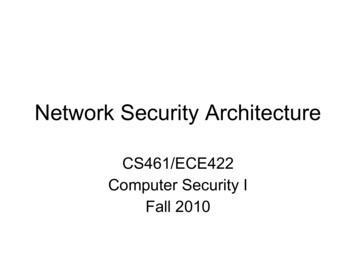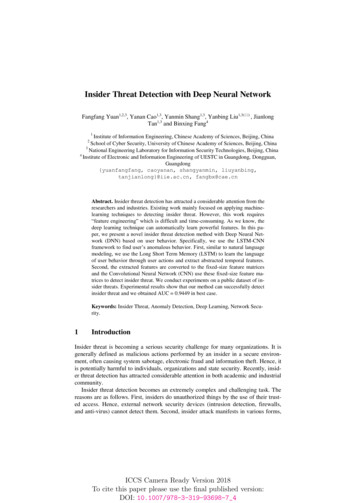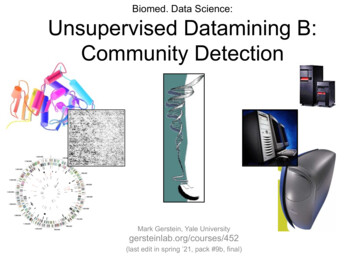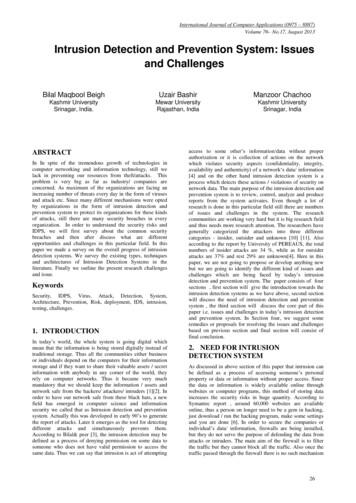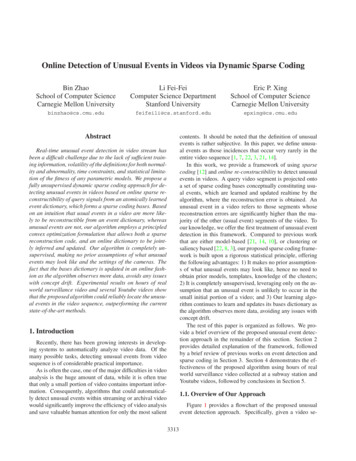
Transcription
Online Detection of Unusual Events in Videos via Dynamic Sparse CodingBin ZhaoSchool of Computer ScienceCarnegie Mellon UniversityLi Fei-FeiComputer Science DepartmentStanford UniversityEric P. XingSchool of Computer ScienceCarnegie Mellon duepxing@cs.cmu.eduAbstractcontents. It should be noted that the definition of unusualevents is rather subjective. In this paper, we define unusual events as those incidences that occur very rarely in theentire video sequence [1, 7, 22, 3, 21, 14].In this work, we provide a framework of using sparsecoding [12] and online re-constructibility to detect unusualevents in videos. A query video segment is projected ontoa set of sparse coding bases conceptually constituting usual events, which are learned and updated realtime by thealgorithm, where the reconstruction error is obtained. Anunusual event in a video refers to those segments whosereconstruction errors are significantly higher than the majority of the other (usual event) segments of the video. Toour knowledge, we offer the first treatment of unusual eventdetection in this framework. Compared to previous workthat are either model-based [21, 14, 10], or clustering orsaliency based [22, 8, 3], our proposed sparse coding framework is built upon a rigorous statistical principle, offeringthe following advantages: 1) It makes no prior assumptions of what unusual events may look like, hence no need toobtain prior models, templates, knowledge of the clusters;2) It is completely unsupervised, leveraging only on the assumption that an unusual event is unlikely to occur in thesmall initial portion of a video; and 3) Our learning algorithm continues to learn and updates its bases dictionary asthe algorithm observes more data, avoiding any issues withconcept drift.The rest of this paper is organized as follows. We provide a brief overview of the proposed unusual event detection approach in the remainder of this section. Section 2provides detailed explanation of the framework, followedby a brief review of previous works on event detection andsparse coding in Section 3. Section 4 demonstrates the effectiveness of the proposed algorithm using hours of realworld surveillance video collected at a subway station andYoutube videos, followed by conclusions in Section 5.Real-time unusual event detection in video stream hasbeen a difficult challenge due to the lack of sufficient training information, volatility of the definitions for both normality and abnormality, time constraints, and statistical limitation of the fitness of any parametric models. We propose afully unsupervised dynamic sparse coding approach for detecting unusual events in videos based on online sparse reconstructibility of query signals from an atomically learnedevent dictionary, which forms a sparse coding bases. Basedon an intuition that usual events in a video are more likely to be reconstructible from an event dictionary, whereasunusual events are not, our algorithm employs a principledconvex optimization formulation that allows both a sparsereconstruction code, and an online dictionary to be jointly inferred and updated. Our algorithm is completely unsupervised, making no prior assumptions of what unusualevents may look like and the settings of the cameras. Thefact that the bases dictionary is updated in an online fashion as the algorithm observes more data, avoids any issueswith concept drift. Experimental results on hours of realworld surveillance video and several Youtube videos showthat the proposed algorithm could reliably locate the unusual events in the video sequence, outperforming the currentstate-of-the-art methods.1. IntroductionRecently, there has been growing interests in developing systems to automatically analyze video data. Of themany possible tasks, detecting unusual events from videosequence is of considerable practical importance.As is often the case, one of the major difficulties in videoanalysis is the huge amount of data, while it is often truethat only a small portion of video contains important information. Consequently, algorithms that could automatically detect unusual events within streaming or archival videowould significantly improve the efficiency of video analysisand save valuable human attention for only the most salient1.1. Overview of Our ApproachFigure 1 provides a flowchart of the proposed unusualevent detection approach. Specifically, given a video se3313
Figure 1. (Best viewed in color) Flowchart of our approach. Given an input video sequence, events are defined using sliding windows (displayed as coloredboxes on the video frames). Within each sliding window, spatio-temporal interest points are detected (not shown in the figure), and a dictionary is learnedusing previously seen video data. For a query event, reconstruction vectors using bases in the dictionary are learned by solving a sparse coding optimizationproblem. Normality of the query event is then decided using these vectors. Finally, the dictionary is updated with the addition of the query event.quence, the proposed method employs a sliding window along both the spatial and temporal axes to define an event.As the sliding window scans along the spatial and temporalaxes, the video is broken into a set of events, each represented by a group of spatio-temporal cuboids. The task ofunusual event detection is therefore formulated as detecting unusual group of cuboids residing in the same slidingwindow. A dictionary is first learnt from the video using sparse coding and later updated in an online fashion as moredata become available. Given the learned dictionary, a reconstruction weight vector is learned for each query eventand a normality measure is computed from the reconstruction vectors. The proposed algorithm only needs to scanthrough the video once, and online updating of the learneddictionary makes the algorithm capable of handling conceptdrift in the video sequence. Finally, using sparse coding enables the algorithm to robustly discriminate between trulyunusual events and noisy usual events.2. Sparse Coding for Unusual Event Detection2.1. Video RepresentationThe proposed unusual event detection algorithm adopts arepresentation based on spatio-temporal cuboids (though itshould be noted that the proposed approach could be appliedover a variety of video descriptors), to detecte salient pointswithin the video and describe the local spatio-temporalpatch around the detected interest points. There have beenseveral attempts in detecting spatio-temporal interest pointsin video sequences [11, 5, 2]. Here, we adopt the spatiotemporal interest points detected using the method in [5],and describe each detected interest point with histogram ofgradient (HoG) and histogram of optical flow (HoF). Figure 2 provides several frames from the video data used inthis paper and the detected spatio-temporal interest pointswithin these frames.2.2. The Proposed MethodGiven a video sequence, the proposed approach employsa sliding window along both the spatial and temporal axesto define an event. Consequently, as a video is represented as a set of cuboids, those cuboids residing in a slidingwindow define an event. As the sliding window scans along the spatial and temporal axes, the video is broken into a set of events, each represented by a group of spatiotemporal cuboids. Specifically, the video is represented asX {X1 , . . . , Xm }, with each event Xi composed of agroup of cuboids, i.e., Xi {X1i , . . . , Xni i }, where ni isthe total number of cuboids within the sliding window.2.2.1 A Sparse Coding FormulationIn this work, detecting unusual events in video is formulated as a sparse coding problem. The basic idea for ourapproach is to represent the knowledge of usual events using the learned dictionary D, whose columns are bases forreconstructing signals. Different from conventional settingsof sparse coding, where the input signal is a vector, the input signal in unusual event detection is an event, composedof a group of cuboids Xi {X1i , . . . , Xni i }. Therefore, thebasic unit of input signal is no longer a vector, but insteada group of vectors, with both spatial and temporal locationinformation. In addition to sparsity of the reconstructionweight vectors, we also need to consider the relationshipsbetween these weight vectors imposed by the neighborhoodstructure of cuboids that define the event.Given dictionary D (details about learning D will beprovided later in this section), we define the following objective function that measures the normality of an eventXi {X1i , . . . , Xni i } and a specific choice of reconstruction weight vectors αi {α1i , . . . , αni i }:J(Xi ,αi ,D) Figure 2. Example spatio-temporal interest points detected with themethod in [5]. 1 j Xi Dαji 22 λ1 αj 12 jj jk 2 λ2 Wjk αi αi 2(1)j,k
where subscripts j and k run through {1, . . . , ni } and λ1 ,λ2 are regularization parameters. We now discuss in detailsof each term in Eq. (1).333322221110000 1 1 1 1 23 23 23 25 32020406080 3100 2020406080 3100 201110001204060804 3100 302040608010020406080100210 1 1 1 1 2 2 3 2 2 4 3020406080100 3020406080100 3020406080100 50Figure 3. First row: usual event (leaving subway exit); second row: unusual event (entering subway exit). From left to right: example frame andsliding window, reconstruction vectors for 3 cuboids, plot all 3 reconstruction vectors on the same figure.Reconstruction error. The first term in Eq. (1) is thereconstruction error. For a usual event, this term should besmall, due to the assumption that the learned dictionary represents knowledge in the previously seen video data. A small reconstruction error means the information within thenewly observed event Xi has appeared in early part of thevideo, which agrees with our definition of usual events.Sparsity regularization. The second term is the sparsity regularization. Enforcing sparsity for reconstructing usual events is necessary due to the fact that dictionary D islearned to maximize the sparsity1 of reconstruction vectorsfor usual events in the video. On the other hand, for unusualevents, although it is possible that a fairly small reconstruction error could be achieved, we would expect using a largeamount of video fragments for this reconstruction, resultingin a dense reconstruction weight vector. Figure 3 presentsthe reconstruction weight vectors for 2 events in the video:the first event is usual, and the second is unusual. Results in Figure 3 show that the reconstruction vectors for usualevent are sparse, while the ones for unusual event are dense.Smoothness regularization. The third term is the smoothness regularization, where W Rn1 n1 is the adjacency matrix of {X1i , . . . , Xni i }, with large value corresponding to neighboring cuboids and small value corresponding to far apart cuboids. This regularization is basedon the fact that similar motions at neighboring patches aremore likely to be involved in a usual event. Consequently,it should be of higher probability for similar reconstructionweight vectors being assigned to neighboring cuboids in ausual event. The adjacency matrix W adopted in this paperis the Gaussian RBF kernel function: xj xk 2 yj yk 2 tj tk 2 (2)Wjk exp 2σ 22σ 22τ 2where (xj , yj ) and tj are spatial and temporal locations ofthe jth cuboid, σ and τ are variances of the Gaussian function. In the last column of Figure 3, where all 3 reconstruction vectors are plotted on the same image, usual event1 In this paper, we define sparsity as the number of zero elements in avector.shows a significant amount of overlap, while the reconstruction vectors for unusual event becomes even denser.In summary, our sparse coding scheme presented aboveencapsulates the following intuitions for what we wouldthink of usual and unusual events. Given a dictionary ofbases corresponding to usual events, a usual event shouldbe reconstructible from a small number of such bases, in away that the reconstruction weights change smoothly overspace/time across actions in such events. On the other hand,an unusual event is either not reconstructible from the dictionary of usual events with small error, or, even if it is reconstructible, it would necessarily build on a combinationof a large number of bases in the dictionary, and possiblyin a temporal-spatially non-smooth fashion. Crucial to thistechnique, is the ability to learn a good dictionary of basesrepresenting usual events, and being able to update the dictionary online to adapt to changing content of the video,which we discuss in detail in next section.2.2.2 OptimizationThe objective function J(Xi , αi , D) of Eq. (1) measuresthe normality of event Xi with any reconstruction weightvector αi and any dictionary D. The lower J is, the morelikely an event Xi is normal. As both αi and D are latentvariables introduced in the formulation, to properly measurethe normality of an event Xi , we need to adopt the optimalweight vector α i and dictionary D which minimize theobjective function for the given event Xi . Specifically, assume there are m events in the video defined using the sliding window, i.e., X {X1 , . . . , Xm }, the optimal reconstruction weight vector α i and dictionary D are learnedby solving the following optimization problem(α 1 , . . . , α m , D ) arg minm α1 ,.,αm ,D i 1J(Xi , αi , D)(3)subject to proper constraints discussed later. A closelook into the above optimization problem reveals that theproblem is convex with respect to the coefficients α {α1 , . . . , αm } of the sparse decomposition when the dictionary D is fixed, and also convex with respect to D whenα is fixed. However, it is not jointly convex with respect toD and α. A natural solution is to alternate between these two variables, minimizing one while clamping the other. Wenote that this alternating optimization algorithm convergesto local optimum. With the learned dictionary D , givena newly observed event X , the algorithm learns the optimal reconstruction weight vector α for this event. Consequently, J(X , α , D ) measures the normality of eventX . An event X is detected as unusual if its correspondingJ(X , α , D ) is larger than certain threshold.Learning Reconstruction Weight Vector (α) withFixed D. With dictionary D fixed, reconstruction weight
vectors for different events are independent. Therefore, theycould be optimized independently. Specifically, for event Xi {X1i , . . . , Xni i }, the corresponding optimizationproblem is as followsmin nα1i ,.,αi i 1 j Xi Dαji 22 λ1 αj 12 jj jk 2 λ2 Wjk αi αi 2(4)Except for the second term, both two other terms in theobjective function are convex quadratic functions of αi .For the above L1 regularized convex function, the objective is not continuously differentiable. Consequently, themost straightforward gradient-based methods are difficultto apply [12]. Various approaches have been proposed tosolve this problem: generic QP solvers (e.g., CVX), interiorpoint method [4], a modification of least angle regression(LARS) [6] and grafting [19]. In this paper, we adopt thefeature-sign search algorithm introduced in [12] to solve theabove L1 regularized optimization method.Learning Dictionary (D) with Fixed α. With fixedcoefficients α, the optimization problem for dictionary Dis as followsDs.t.m1 Xji Dαji 222m i 1 j 1,.,n(5)D Rm k(6)i j 1, . . . , k,dTj dj 1minD Cj,kminfirst learn an initial dictionary using an initial portion of thevideo, and update this learned dictionary using each newlyobserved event.Assume the algorithm has observed t-th event in thevideo, the optimal dictionary is the solution of the followingoptimization problem(7)The constraint in (7) is introduced to prevent terms in Dfrom being arbitrarily large, which would result in arbitrarily small values of α [12]. The above optimization problemis a least squares problem with quadratic constraints. In thiswork, we solve this problem using Lagrange dual.2.3. Online Dictionary UpdateAs we stated in the Introduction, one contribution of ourwork is to automatically learn the video dictionary and perform ongoing learning as we continue to observe the sequence. Unlike previous work where a model for usualevents is first learned using training data [3, 10, 1], our fully unsupervised framework can be much more practical inreal-world scenarios.Specifically, the above formulation needs initial trainingdata to learn the dictionary. In video surveillance, it is oftenchallenging to obtain such suitable training data. Even ifwe were provided with a set of training data, we postulatethat the bases dictionary learned from the training data isnot necessarily optimal for detecting unusual events in newquery videos. We therefore propose an online dictionarylearning algorithm in this section that requires no trainingdata other than the video sequence itself. Our idea is tot1 Xji Dαji 222t i 1 j 1,.,n(8)iwhere C {D Rm k : dTj dj 1, j 1, . . . , k}.Ideally, to solve this problem, we would need all t events{X1 , . . . , Xt }. However, storing these events requires hugespace and solving the optimization problem from scratch istime consuming. Therefore, the online algorithm we propose here aims to finding the optimal dictionary Dt givenDt 1 and Xt . Specifically, we use projected first order stochastic gradient descent, consisting of the following update [15]: ηDt ΠC Dt 1 D l(Xt , Dt 1 )(9)t where l(Xt , Dt 1 ) 12 j 1,.,nt Xjt Dt 1 αjt 22 , η isthe learning rate, ΠC is the orthogonal projection onto C.2.4. Unusual Event DetectionAs briefly mentioned in previous section, given a newly observed event X and the current dictionary D , theproposed algorithm learns the corresponding optimal reconstruction weight vector α . X is detected as an unusualevent if the following criterion is satisfiedJ(X , α , D ) ˆ (10)where ˆ is a user defined threshold that controls the sensitivity of the algorithm to unusual events. Combining everything together, Algorithm 1 presents our unusual eventdetection method.Algorithm 1 Unusual event detection using sparse codingInput: video data, learning rate η, threshold ˆLearn initial dictionary using first N frames in videorepeatUse sliding window to obtain event XtLearn optimal reconstruction vectors αt for event Xtby solving Eq. (4) with D Dt 1if J(Xt , αt , Dt 1 ) ˆ thenFire alarm for event Xtend ifUpdate dictionary D with Eq. (9)until reach the end of video
3. Related WorksSeveral attempts have been proposed in the literature onunsupervised unusual event detection in videos [1, 7, 22,3, 21, 14]. Specifically, [7, 20, 9] studies the problem using tracking trajectories. However, even with the recent advances in tracking techniques, reliably tracking an object incrowded video is still a very challenging research problem.Clustering methods [22, 8] have also been applied to detectunusual events, where the detection is carried out by findingspatially isolated clusters. The fact that these methods onlyrun in batch mode severely limits their applicability. [1] proposes a simple yet effective approach that measures typicalflow directions and speeds on a grid in the video frame todetect unusual events. This algorithm is good for detectingsimple events such as moving in the wrong direction. [3]proposes a database indexing algorithm, where the problemis formulated as composing the new observed video datausing spatio-temporal patches extracted from previous visual examples. Regions in the query video that can be composed using large contiguous chunks of data from the example database are considered normal. Although this algorithm shows good performance in discriminating complexmotions, it faces scalability issues as its time and memorycomplexity is linear in the size of the example database. Finally, [10] utilizes a space-time Markov random field to detect unusual events, where an MRF model is built for usualevents and those events that could not be described with thelearned model is considered as unusual.On the other hand, sparse coding [12] has shown promising results in finding succinct representations of stimuli. Forexample, applying sparse coding algorithm to natural images has been shown to be capable of learning the basesresembling the receptive fields of neurons in the visual cortex [17, 18]. Moreover, sparse coding has been shown toproduce localized bases when applied to other natural stimuli such as video and speech [16, 13]. Different from conventional sparse coding, where the bases in dictionary arefixed after training, the dictionary in our dynamic sparsecoding framework is updated online to adapt to changingcontent of the video.4. ExperimentsIn this section, we show the empirical performance ofthe proposed unusual event detection algorithm, both qualitatively and quantitatively.4.1. Subway Surveillance VideoThe first 2 data sets are video sequences taken fromsurveillance camera at a subway station, with one cameramonitoring the exit and the other monitoring the entrance.In both videos, there are roughly 10 people walking aroundin a typical frame, with a frame size of 512 384. Thevideos are provided by courtesy of Adam et al. [1] and wecompare quantitatively the detection results of our approachagainst the method in [10].4.1.1 Subway ExitThe subway exit surveillance video is 43 minutes long with64901 frames in total. To ensure a fair qualitative comparison, we follow the same definition of unusual events usedin [10] for the same data set, though it should be noted thatthe definition of unusual events is rather subjective. Specifically, 3 types of unusual events are defined in the subwayexit video: (a) walking in the wrong direction (WD); (b)loitering near the exit (LT) and (c) misc, including suddenly stop and look around, janitor cleaning the wall, someonegets off the train and gets on again very soon. Totally, 19unusual events are defined as ground truth.We use a sliding window of size 80 80 pixels alongx and y axes, and 40 frames along t axis in our approach.The fist 5 minutes of the video, same as in [10], is used tobuild initial dictionary. Before providing the unusual eventdetection results, we first show the dictionary learned usingour approach in Figure 4. Specifically, Figure 4 visualizesFigure 4. Dictionary learned using our approach for subway exit surveillance video. Each row in the figure corresponds to a basis in the dictionary.Typical activities in this dictionary include: walking to the left or right,walking towards the camera, train leaving station, etc.randomly selected 10 bases in the learned dictionary (thesize of the learned dictionary is 100). We observe that thelearned bases of the dictionary reflects our intuition aboutwhat common and usual events are in this video: peoplewalking towards the camera (exiting the subway), walkingto the left or right, train leaving station, etc. Table 1 provides quantitative results on unusual event detection accuracy and false alarm rate. We follow the same annotationused in [10], where a frame range is defined for each unusual event. For evaluation, once the algorithm detects at leastone frame in the annotated range, the detection is countedas correct. On the other hand, false alarm is also measuredin the same way: at least one frame is fired outside the annotated range, then it is counted as false alarm2 . Figure 52 There are other evaluation metrics which could also be reasonable. Weuse this evaluation metric to be able to compare with [10].
WD LT MISC Total FAGT937190ST-MRF [10]937193Ours937192Table 1. Comparison of unusual event detection rate and false alarm rateon subway exit surveillance data: GT stands for ground truth annotation;ST-MRF refers to the method proposed in [10].Figure 5. Unusual event detection in the subway exit surveillance video.WD: wrong direction; LT: loitering; MISC: misc; FA: false alarm. Therectangle on the figure marks the sliding window that results in the detection of unusual events. False alarms are marked using green sub-window.(WD); (b) no payment (NP); (c) loitering (LT); (d) irregular interactions between people (II) and (e) misc, includingsudden stop, running fast.We use the same sliding window as in subway exit video,and the fist 15 minutes for training as in [10]. Figure6 shows the dictionary learned by our approach, wherewe randomly select 12 bases out of 200 in the dictionary. This dictionary shows activities such as people walking to the left or right, walking away from the camera,which are usual events in this video. Quantitative compar-Figure 6. Dictionary learned using our approach for subway entrancesurveillance data. Each row in the figure corresponds to a basis in thedictionary. Typical activities in this dictionary include: walking to the leftor right, walking away from the camera, etc.shows the detection results on the subway exit data, including the correct detections, and false alarms. Our methodcan detect an unusual event even within a crowded scenewith occlusions (e.g., Figure 5(d)). Also, we can see thatour method captures the unusual event caused by fine scaleirregular motion (e.g., Figure 5(k)), or abnormal event resulted by irregular temporal ordering of activities (e.g., Figure 5(j)). We also illustrate two false alarms detected by ouralgorithm (Figure 5(o) & (p)). Curiously, looking closer into the video, these two events are indeed “unusual”: Figure5(o) is due to the first appearance of a child, and Figure5(p) is due to the action of a man stopping near the exit andlooking back. They are missed in ground truth annotations,hence labeled as FA in evaluation.Time Complexity: We implement our algorithm usingMATLAB 7.0 on a 2.60GHZ Intel CoreTM2 Duo PC with2.0GB main memory. Learning initial dictionary took about20 minutes. For each sliding window, learning reconstruction vectors took 0.2 seconds on average. In each frame,there are roughly 10 sliding windows being tested for unusual events. Consequently, unusual event detection in eachframe was done in about 2 seconds.ison results with [10] are shown in Table 2, where our approach achieves higher detection rate and fewer false alarms. Moreover, as reported in [10], the approach in [1] failsto detect abnormal activities with irregular temporal orderings, such as Figure 5(j), people getting off the train andgetting back quickly. Also, the method in [1] results in anorder magnitude more false alarms than [10]. Moreover, theclustering-based method [22] cannot detect events happening at a fine local scale, such as Figure 7(e) & (f). Therefore, while achieving slightly better qualitative performancethan [10], our method also clearly outperforms the methodsin [1] and [22] by a large margin.Figure 7 displays unusual events detected using our approach. Our method not only detects abnormalities in afine scale (e.g., Figure 7(e) & (f)), but also unusual eventscaused by irregular interactions between people (e.g., Figure 7(j)). Moreover, we can see that our method could correctly detect abnormal activities where both usual and unusual events occur in the same frame (e.g., Figure 7(g)).4.1.2 Subway EntranceIn our approach, the learned dictionary is updated after observing each new event using projected stochastic gradientdescent. In this section, we compare the results of our algorithm with the method using initially learned dictionarythroughout the entire video sequence. Specifically, in theThe subway entrance video is 1 hour 36 minutes long with144249 frames in total. 66 unusual events are defined, covering 5 different types: (a) walking in the wrong direction4.1.3 Analysis Experiment:Learned DictionaryOnline Update of the
number of videos from YouTube. As Figure 8 shows, thesevideos have very different camera motion (rotation, zoomin/out, fast tracking, slow motion, etc.), contains differentcategories of targets (human, vehicles, animals, etc.) andcovers a wide variety of activities and environmental conditions (indoor, outdoor).For each of the 8 Youtube videos, we use approximatelythe first 1/5 of video data to learn an initial dictionary, anddisplay detected unusual events in Figure 8. With no modelassumptions of what is unusual, no need for templates, nosupervision or training, our method could correctly detectabnormal activities in these real world low-quality videos.5. ConclusionsFigure 7. Unusual event detection in the subway entrance surveillancevideo. WD: wrong direction; NP: no payment; LT: loitering; II: irregularinterations; MISC: misc; MISS: missed unusual event; FA: false alarm.WD NP LT II MISC Total FAGT261314 49660ST-MRF [10]24813 48576Ours25914 48605Table 2. Comparison of unusual event detection rate and false alarm rateon subway entrance surveillance data.Fixed DOursCorrect Detection17/5419/60False Alarm8/122/5Table 3. Comparison of unusual event detection rate and false alarm rate:online updating dictionary vs. fixed dictionary. The number before ’/’ isfor subway exit surveillance data, while the number after ’/’ is for entrancesurveillance data.subway exit surveillance data, the second method learns aninitial dictionary using the first 5 minutes of video and keepthis dictionary fixed in the entire detection process. Similarly, in the subway entrance video data, the second methodemploys the fixed dictionary learned from first 15 minutesof video. Table 3 compares the detection accuracy and falsealarms of the two methods. The method using fixed dictionary generally gives more false alarms than our approach.This result underscores our contribution in developing anonline learning framework to update the bases dictionary.Without the online updates, the Fixed Dictionary methodshows the inability for adapting to the changing contents ofthe video, resulting in a much greater error rate.4.2. Unusual Event Detection in Youtube VideosThe above experiment has demonstrated our model’s superiority in unusual event detectio
in video sequences [11, 5, 2]. Here, we adopt the spatio-temporal interest points detected using the method in [5], and describe each detected interest point with histogram of gradient (HoG) and histogram of optical flow (HoF). Fig-ure 2 provides several frames from the video data used in this paper and the detected spatio-temporal interest points
